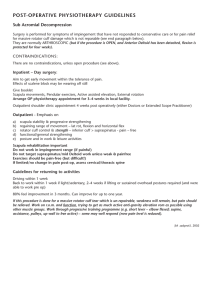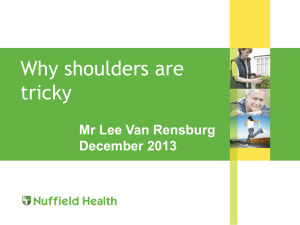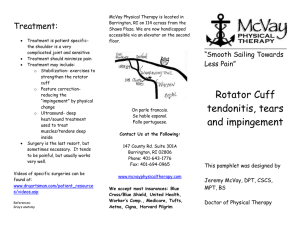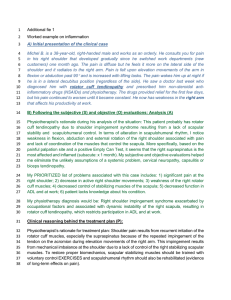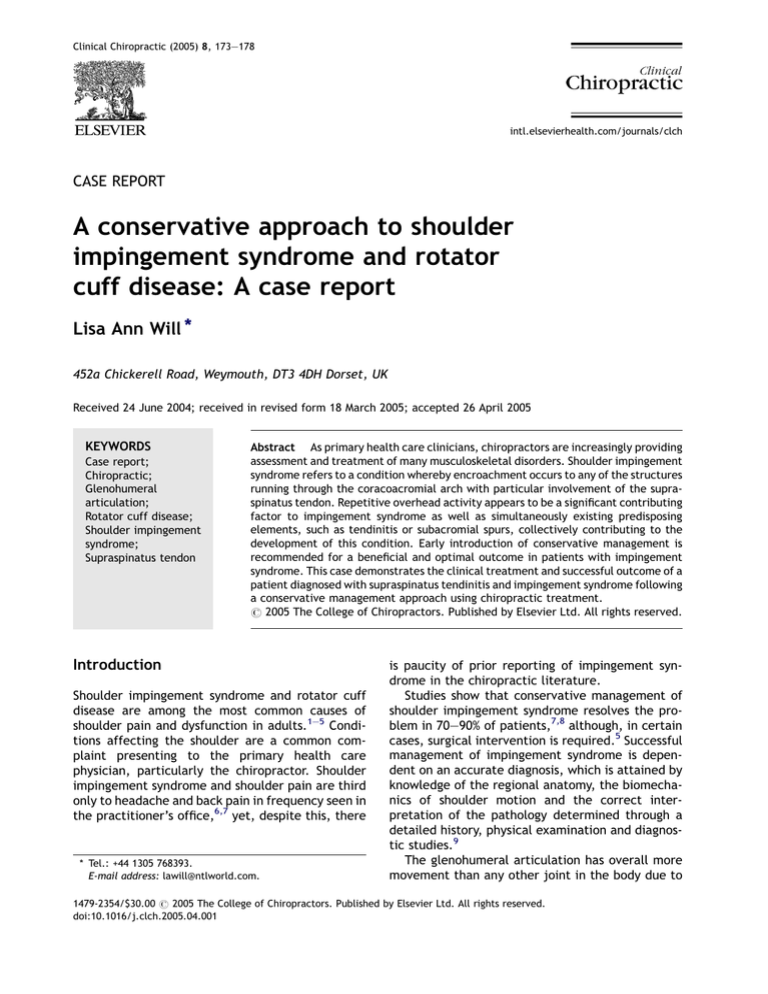
Clinical Chiropractic (2005) 8, 173—178
intl.elsevierhealth.com/journals/clch
CASE REPORT
A conservative approach to shoulder
impingement syndrome and rotator
cuff disease: A case report
Lisa Ann Will *
452a Chickerell Road, Weymouth, DT3 4DH Dorset, UK
Received 24 June 2004; received in revised form 18 March 2005; accepted 26 April 2005
KEYWORDS
Case report;
Chiropractic;
Glenohumeral
articulation;
Rotator cuff disease;
Shoulder impingement
syndrome;
Supraspinatus tendon
Abstract As primary health care clinicians, chiropractors are increasingly providing
assessment and treatment of many musculoskeletal disorders. Shoulder impingement
syndrome refers to a condition whereby encroachment occurs to any of the structures
running through the coracoacromial arch with particular involvement of the supraspinatus tendon. Repetitive overhead activity appears to be a significant contributing
factor to impingement syndrome as well as simultaneously existing predisposing
elements, such as tendinitis or subacromial spurs, collectively contributing to the
development of this condition. Early introduction of conservative management is
recommended for a beneficial and optimal outcome in patients with impingement
syndrome. This case demonstrates the clinical treatment and successful outcome of a
patient diagnosed with supraspinatus tendinitis and impingement syndrome following
a conservative management approach using chiropractic treatment.
# 2005 The College of Chiropractors. Published by Elsevier Ltd. All rights reserved.
Introduction
Shoulder impingement syndrome and rotator cuff
disease are among the most common causes of
shoulder pain and dysfunction in adults.1—5 Conditions affecting the shoulder are a common complaint presenting to the primary health care
physician, particularly the chiropractor. Shoulder
impingement syndrome and shoulder pain are third
only to headache and back pain in frequency seen in
the practitioner’s office,6,7 yet, despite this, there
* Tel.: +44 1305 768393.
E-mail address: lawill@ntlworld.com.
is paucity of prior reporting of impingement syndrome in the chiropractic literature.
Studies show that conservative management of
shoulder impingement syndrome resolves the problem in 70—90% of patients,7,8 although, in certain
cases, surgical intervention is required.5 Successful
management of impingement syndrome is dependent on an accurate diagnosis, which is attained by
knowledge of the regional anatomy, the biomechanics of shoulder motion and the correct interpretation of the pathology determined through a
detailed history, physical examination and diagnostic studies.9
The glenohumeral articulation has overall more
movement than any other joint in the body due to
1479-2354/$30.00 # 2005 The College of Chiropractors. Published by Elsevier Ltd. All rights reserved.
doi:10.1016/j.clch.2005.04.001
174
the minimal bony stability in the shoulder permitting a wide range of motion (ROM). In order to
achieve peak performance, there must be optimal
balance between mobility and stability.2,9 Due to
the limited bony structures, the shoulder is inherently unstable, thus the soft tissue structures (static
and dynamic stabilisers) are the major glenohumeral stabilisers.9 However, excessive or repetitive
strain of the shoulder complex can impair the balance between mobility and stability, placing the
shoulder at risk for a variety of disorders.3,9,10
The purpose of this paper is to illustrate how a
patient presenting with bilateral shoulder pain
responded to conservative chiropractic management. Specific emphasis will be placed on repetitive
motion disorders, rotator cuff disease and impingement syndrome and their relation to shoulder anatomy and motion as well as differential diagnosis of
impingement syndrome.
Case presentation
The patient was a 38-year-old manual worker, who
presented with bilateral shoulder pain of 4 weeks’
duration associated with cervical spine pain and
stiffness. He had a history of cervical spine pain
and stiffness, which resolved after having chiropractic treatment. Other than the previous episodes of
neck pain, he had enjoyed good health until the
recent onset of bilateral shoulder pain. The patient
attributed the shoulder pain to a change in the
method of lifting in his work as an industrial roofer,
which involved repetitive heavy overhead lifting
and neck flexion and extension.
The patient described his shoulder pain as aching
most of the time, although he would experience a
sharp pain and catching sensation at about 808 of
arm abduction bilaterally. The pain was located
bilaterally, primarily at the biceps tendon region
near to the shoulder joint, although also directly
distal to the tip of the acromion and at the deltoid
muscle insertion. Abduction of the arm above 808
and internal rotation of the glenohumeral joint
aggravated the pain.
On examination, no atrophy of the shoulder muscles was observed; however, on closer observation,
some apparent hypertrophy of the supraspinatus
muscle was noted on the right. Multiple myofascial
trigger points were present over the right bicipital
groove, trapezius, infraspinatus and rhomboid muscles and along the supraspinatus muscle and its
insertion. The left shoulder revealed tenderness
over the bicipital groove and the supraspinatus
muscle. Muscle strength testing disclosed pain of
the right shoulder joint when testing supraspinatus,
L.A. Will
Table 1 Active range of motion of each shoulder in
the patient.
Flexion
Extension
Internal rotation
External rotation
Adduction
Abduction
Right
shoulder (8)
Left
shoulder (8)
160
55
70
60
35
150
180
55
70
70
35
160
infraspinatus and subscapularis muscles and pain in
the left shoulder when testing subscapularis and
infraspinatus muscles. The active ROM of each
shoulder is detailed in Table 1. A painful arc was
noted on active abduction bilaterally between 808
and 1308. Orthopaedic examination of the shoulder
revealed positive tests when carrying out right Yergason’s, Impingement sign, ‘‘empty can position’’
and bilateral Drop arm test and Kennedy-Hawkins
test. Segmental posterior joint dysfunction was
noted within the upper cervical spine as well as
the upper thoracic spine. All other routine orthopaedic tests for the neck region were negative.
The history and the clinical examination findings
strongly suggested a diagnosis of moderate right
supraspinatus tendinitis and left supraspinatus
strain with bilateral impingement syndrome. The
patient was treated four times during a 15-day
period. The clinical plan consisted of cross friction
massage and trigger point therapy of the bicipital
and supraspinatus tendons, and supraspinatus,
infraspinatus, rhomboid and trapezius muscles, followed by stretching of these muscles and cryotherapy. A course of shoulder mobilisation exercises
aimed at increasing the restricted shoulder ROM
was introduced in the second treatment. Spinal
manipulative therapy was applied to the involved
segmental spinal levels. Ergonomic advice regarding
the use of his arms at work was provided. On the
sixth visit, the patient viewed the improvement to
be 40% with a great reduction in the frequency of
catching sensation when taking the arm into abduction. At this time, the patient was given rehabilitative home exercises, which included ROM exercises,
shoulder girdle stretching and strengthening.
Nearly two months after the onset of the treatment, the patient reported that that he no longer
had left shoulder problems and that there was
resolution of the catching that was felt on shoulder
abduction. However, the right shoulder still experienced an occasional ‘‘locking’’ sensation on abduction, although there was an improvement in ROM
and reduction in pain with an overall 60% improvement as viewed by the patient.
Shoulder impingement syndrome and rotator cuff disease
Examination of the shoulders revealed no tenderness to palpation over the bicipital groove bilaterally and left shoulder girdle muscles; right
Yergason’s, Impingement sign and ‘‘empty can position’’ were negative as was left Painful arc test and
bilateral Drop arm test and Kennedy-Hawkins test.
Although active ROM was full and pain-free on the
left, there was still a positive Painful arc test and a
reduction in abduction on the right (1608). A further
five treatments were carried out; however, there
was no further improvement and the patient still
experienced some pain and occasional catching on
abduction. This was regarded as a maximal outcome
and the patient was released from care.
Discussion
Impingement syndrome
In 1972, Neer11 first introduced the concept of
rotator cuff impingement to the literature, stating
that it resulted from mechanical impingement of
the rotator cuff tendon beneath the anteroinferior
portion of the acromion, especially when the
shoulder is placed in the forward-flexed and internally rotated position.12 He reported that about 90%
of rotator cuff tears are a result of subacromial
impingement from supraspinatus outlet narrowing.
The supraspinatus outlet is a space formed on the
upper rim, humeral head, and glenoid by the acromion, coracoacromial arch and acromioclavicular
joint. This outlet accommodates the passage and
excursion of the supraspinatus tendon. Abnormalities of the supraspinatus outlet have been attributed as a cause of impingement syndrome and
rotator cuff disease,13 as has rotator cuff weakness.14 Other causes are detailed in Table 2.
According to the literature, anatomical variants
of the acromion have been shown to correlate with
impingement.5,15 The acromion has been classified
into three types based on the shape of its inferior
surface: flat (type I), curved (type II) and hooked
(typed III).1 The latter two types have been implicated as a causative factor in the development of
impingement syndrome leading to rotator cuff
pathology.16
Research carried out by Neer on impingement
was based on cadaveric dissections11 and clinical
and surgical experience.3,9 He established a classification system11 that defines three stages in the
spectrum of rotator cuff impingement that follow a
pattern of severity. Stage 1 is depicted by acute
inflammation, oedema and haemorrhage in the
rotator cuff. In stage 2, the rotator cuff tendon
progresses to fibrosis and tendinitis. As this condi-
175
Table 2
Causes of rotator cuff tendinopathy.2
Extrinsic causes
Primary impingement
Increased subacromial loading
Acromial morphology (shape, slope, spur,
os acromiale)
Acromioclavicular arthrosis (inferior osteophytes)
Coracoacromial ligament hypertrophy
Coracoid impingement
Subacromial bursal thickening and fibrosis
Prominent humeral greater tuberosity
Trauma (direct macrotrauma or repetitive
microtrauma)
Overhead activity (athletic and non-athletic)
Secondary impingement
Rotator cuff overload/soft tissue imbalance
Eccentric activity
Glenohumeral laxity/instability
Biceps and biceps labral complex tears
Long head of biceps tendon laxity/weakness
Muscle imbalance
Scapular dyskinesia
Posterior capsular tightness
Trapezius paralysis
Intrinsic causes
Impaired cuff vascularity
Ageing (primary)
Impingement (secondary)
Primary tendinopathy
Intratendinous injury
Articular-side partial-thickness tears
Calcific tendinopathy
tion progresses, it may lead to mechanical disruption of the rotator cuff tendon and to changes in the
coracoacromial arch with osteophytes along the
anterior acromion. These changes are consistent
with stage 3 of the Neer classification. In all Neer
stages, aetiology is impingement of the rotator cuff
tendons under the acromion and a rigid coracoacromial arch, eventually leading to degeneration and
tearing of the rotator cuff tendon.
The most commonly affected muscle in shoulder
impingement syndrome is the supraspinatus muscle,
as it inserts between the inferior portion of the
acromion process and the superior aspect of the
head of the humerus.9 As shoulder abduction occurs,
the rotator cuff tendons are placed under compressive force, the deltoid exerts a force that causes the
head of the humerus to move superolaterally, compressing the tendons between the humerus, subdeltiod bursa and the inferior surface of the acromion
process.3,6 The rotator cuff tendons — particularly
the supraspinatus tendon — are relatively avascular,
and this region of the tendon is referred to as the
‘‘critical zone’’.7,17,18 The critical zone is further
176
reduced by abduction and also has a limited ability
to repair from microtrauma and, thus, is subjected
to inflammation and oedema, which further reduce
the already narrow supraspinatus outlet.4,5 The long
head of biceps and the subacromial bursa are commonly affected by the rotator cuff changes occurring in impingement syndrome due to their
proximity in the shoulder region.3,4
Recent studies using three-dimensional motion
analysis show that patients with shoulder disorders
have alterations in the shoulder girdle motion patterns.19,20 A recent study19 shows that patients with
impingement syndrome may demonstrate an increase in glenoid rotation angle and alterations in
the scapulo-humeral rhythm and supraspinatus
motion; thus, these patients may benefit from an
alternative type of treatment management. Herbert et al.20 concluded that patients with shoulder
impingement syndrome with less anterior scapular
tilting in the symptomatic shoulder as compared
with the asymptomatic shoulder may be at high risk
of developing chronic impingement syndrome.
Therefore, it would be beneficial for future research
to focus on rehabilitative protocols that aim towards
restoration of abnormal scapular behaviour in
patients with impingement syndrome.
Pathogenesis and repetitive motion in
impingement syndrome
The relationship between repetitive motion and
impingement syndrome and rotator cuff disease
remains incompletely understood.3 However, the
mechanism of rotator cuff disease following subacromial impingement is widely accepted.1,7
Impingement and rotator cuff disease are
increasingly more common in sports or activity that
involves repetitive overhead motion.3,6,9,10 There
are multiple aetiologic factors that may contribute
to the development of impingement during repetitive motion activities. These factors may be divided
into patient-related factors (age, supraspinatus outlet anatomy and pre-existing rotator cuff pathology)
and work-related factors (arm position, weight lifting requirements and number of repetitions).21
The humeral head has a tendency for superior
translation between 608 and 908 of elevation due to
the tangential vector of deltoid contraction. Therefore, repetitive activities in this range of abduction
place a great demand on the rotator cuff muscles to
counteract this tendency. Higher levels of repetitive
elevation of the arm bring the greater tuberosity
and supraspinatus tendon into close proximity. Thus,
if there are confounding anatomical factors such as
a greater tuberosity spur or inferior acromioclavi-
L.A. Will
cular osteophytes that contribute to supraspinatus
outlet narrowing, repetitive overhead activities
could lead to impingement symptoms.3,16 Endurance of the scapular rotators is required to maintain
correct scapular rotation during sustained or repetitive overhead activities.22,23 Fatigue of the scapular rotators may result in relative impingement due
to poor or asymmetric scapular rotation.1
The physical demand of repetitive work activities
involved in manual labour may also contribute to the
development of impingement syndrome. High
demand of work may be manifested by the repetitions required, the force with which the activity is
performed and the length of time required in the
shift or activity. A financial incentive to work harder
or longer may, therefore, have an effect on the
development of symptomatic impingement syndrome.21 In relation to the case presented, the
patient owned the industrial roofing business in
which he worked and thus there is possibly a higher
incentive to work in order to obtain financial security with a greater likelihood of the development of
impingement syndrome and, due to the continuation of work during and after treatment, the prognosis is worsened as repetitive motion is being
carried out daily, despite the need to rest the
damaged structures.
Also of importance in the aetiology of impingement syndrome in association with repetitive
motion is the age of the patient.3 Research reveals
that impingement syndrome has a higher prevalence
in the third decade of life and that there are normal
age-related increases in asymptomatic rotator cuff
defects.13,24
Anatomy
The shoulder joint is a multiaxial spheroid joint. The
minimal bony stability in the shoulder permits a
wide range of motion and the soft tissue structures
are the major glenohumeral stabilisers. Several
interconnecting ligaments and layers of muscles join
these bones, providing the rather unstable joint
with a great amount of strength.2,9 Due to the
curvature of the articular surfaces of the shoulder,
the joint is not congruent and is referred to as
‘‘loose packed’’. It is only when the humerus is
abducted and externally rotated that it becomes
close packed and a congruent joint.2
The rotator cuff consists of four muscles, which
reinforce the fibrous capsule and control three basic
motions: abduction, internal rotation and external
rotation. The supraspinatus lies above the joint,
while the infraspinatus and teres minor muscles
cross the joint posteriorly; all three muscles insert
Shoulder impingement syndrome and rotator cuff disease
onto the greater tubercle of the humerus. Subscapularis is the fourth rotator cuff muscle, attaching
from the anterior surface of the scapula, crossing
the glenohumeral joint anteriorly and inserting onto
the lesser tubercle of the humerus.2,7,9 The rotator
cuff muscles provide dynamic stabilisation to the
humeral head on the glenoid fossa, forming a force
couple with the deltoid to allow elevation of the
arm. This force couple is responsible for 45% of
abduction strength and 90% of external rotation
strength. Static stabilisers consist of the articular
anatomy, glenoid labrum, joint capsule, glenohumeral ligaments, and inherent negative pressure in
the joint. Dynamic stabilisers include the rotator
cuff muscles, long head of the biceps tendon, scapulothoracic motion, and other shoulder girdle muscles (e.g., pectoralis major, latissimus dorsi, and
serratus anterior).2
Diagnosis of shoulder complaints
Shoulder pain and impingement syndrome can be
mistaken for other relatively common conditions
involving the shoulder. Therefore, careful history
taking and clinical and radiographic examination
procedures are important to avoid misdiagnosis
(Table 3) and mismanagement.
Treatment
The treatment choice for shoulder impingement
syndrome is conservative and varies with the stage
of the complaint, the level of progression and the
level of shoulder motion involved in the patient’s
daily activity.7,13
According to several authors, conservative management and rehabilitation is important for a successful outcome and should be continued for at least
3—6 months or longer,7,8,10,25 after which 60—90% of
Table 3
drome.
Differential diagnosis of impingement syn-
Arthritis of the glenohumeral joint
Adhesive capsulitis
Bursitis
Intra-muscular adhesions
Acromioclavicular pathology
Subscapular nerve injury
Cervical disc lesion
Cervical nerve root lesion
Subscapular nerve injury
Thoracic outlet syndrome
Pancoast tumour
177
cases will have resolved.16 In a study carried out by
Wang et al.,16 the success rate of conservative
management in patients with impingement syndrome was 73.8% regardless of the acromial morphology present. If the patient remains significantly
disabled and has no improvement after conservative
treatment, surgical treatment may be considered.
Early therapeutic goals include the reduction of
inflammation, swelling and pain.15 Cryotherapy is
particularly beneficial during the acute inflammatory stage or for the chronic recurrent exacerbation.1,2,7,8 Stretching and strengthening of the
rotator cuff muscles should be performed while
avoiding the impingement positions and, once pain
and inflammation have reduced, active and passive
ROM exercises should be incorporated with gentle
oscillation and mobilisation.7 One recent in vivo
study shows, for the first time, that adducting muscle forces lead to a significant increase of the subacromial space width compared with abducting
muscle activity.26 Thus, future physical therapy protocols should focus on increasing the depressor
effect of adducting muscles in the postoperative
and conservative treatment of impingement syndrome of the shoulder. This early rehabilitative
activity allows for neurological reintegration of
neuromuscular structures.
The pumping action of moving muscles expedites
lymphatic flow, the input of nutritional blood-borne
factors and the withdrawal of inflammatory cellular
debris and chemotactic factors. In those whose work
or lifestyle involves repetitive overhead activity, the
rotator cuff muscles are being placed in the impingement position frequently and they must be in
balance. This requires anterior and posterior
strength and flexibility.10 This could also explain
why the patient in the case still experienced pain
in the right shoulder due to a lack of compliance
with rehabilitative exercises or stretches and also
the continuation of overhead activity.
The chiropractic physician will also want to asses
the five joint complexes (the glenohumeral joint,
the acromioclavicular joint, the sternocostal joints,
the costovertebral joints and the scapulothoracic
articulation) that are part of the kinetic chain
affecting the shoulder as well as assessing the spine
for involvement.
Impingement and injury to the rotator cuff muscles could result in damage to the neural mechanoreceptors that mediate normal proprioceptive
sensation of the shoulder.27 This deficit could lead
to slow protective reflexes, where contraction of
the muscles occurs too late to protect the joint.
Thus, the resultant proprioception deficit could
contribute to chronic instability and further injury
of the shoulder joint. Thus, kinaesthetic and
178
proprioceptive exercises should be incorporated
into the shoulder rehabilitation programme.
Conclusion
Shoulder pain and shoulder impingement syndrome
are common complaints presenting to the primary
health care practitioner. The relationship between
repetitive motion and impingement syndrome is
possibly more complex than simple cause and
effect. Thus, the goal of future research in this field
should be to identify work-related and patientrelated factors that may contribute to the development of impingement and rotator cuff disease.
Investigating the treatment options for shoulder
complaints is crucial for developing optimal treatment approaches for those patients presenting with
shoulder pain as a result of impingement syndrome
and rotator cuff disease for a better long term
prognosis. When the correct diagnosis is reached,
a co-ordinated effort of conservative management
by both the physician and patient enables most
patients to return to their prior level of activity.
References
1. Frieman BG, Albert TJ, Fenlin Jr JM. Rotator cuff disease: a
review of diagnosis, pathophysiology, and current trends in
treatment. Arch Phys Med Rehab 1994;75(5):604—9.
2. Evans PJ, Maniaci A. Rotator cuff tendinopathy: many causes,
many solutions. J Musculo Med 1997;14:47—61.
3. Cohen RB, Williams Jr GR. Impingement syndrome and rotator cuff disease as repetitive motion disorders. Clin Orthop
1998;351:95—101.
4. Faber KJ, Singleton SB, Hawkins RJ. Rotator cuff disease:
diagnosing a common cause of shoulder pain. J Musculo Med
1998;15:15—25.
5. Lyons PM, Orwin JF. Rotator cuff tendinopathy and subacromial impingement syndrome. Med Sci Sports Exerc
1998;30(4):S12—7.
6. Roodman WU. Etiologies of shoulder impingement syndrome
in competitive swimmers. Chiro Sports Med 1989;3:27—31.
7. Shrode LW. Treating shoulder impingement using the supraspinatus synchronization exercise. JMPT 1994;17(1):43—53.
8. Morrison DS, Frogameni AD, Woodworth P. Non-operative
treatment of subacromial impingement syndrome. J Bone
Joint Surg Am 1997;79(5):732—7.
L.A. Will
9. Cavallo RJ, Speer KP. Shoulder instability and impingement
in throwing athletes. Med Sci Sports Exerc 1998;30(4):S18—
25.
10. Ingber RS. Shoulder impingement in tennis/racquetball
players treated with subscapularis myofascial treatments.
Arch Phys Med Rehabil 2000;81:679—81.
11. Neer CS. Impingement lesions. Clin Orthop 1983;173:70—7.
12. Kim TK, McFarland EG. Internal impingement of the shoulder
in flexion. Clin Orthop Relab Res 2004;421:112—9.
13. Almekinders LC. Impingement syndrome. Clin Orthop 2004;
1(421):112—9.
14. Burke WS, Vangsness CT, Powers CM. Strengthening the
supraspinatus: a clinical and biomechanical review. Clin
Orthop 2002;402:292—8.
15. Cakmak A. Conservative treatment of subacromial impingement syndrome. Clin Sports Med 2001;20(3): 491—
504.
16. Wang JC, Horner G, Brown ED, Shapiro MS. The relationship
between acromial morphology and conservative treatment of
patients with impingement syndrome. Orthopedics 2000;
23(6):557—9.
17. Lohr JF, Uhthoff HK. The microvascular pattern of the supraspinatus tendon. Clin Orthop 1990;254:35—8.
18. Neviaser RJ, Neviaser TJ. Observations on impingement. Clin
Orthop 1990;54:60—3.
19. Graichen H, Stammberger T, Bonel H, Weidemann E, Englmeier KH, Reiser M, et al. Three-dimensional analysis of
shoulder girdle and supraspinatus motion patterns in patients
with impingement syndrome. J Orthop Res 2001;19(6):
1192—8.
20. Herbert LJ, Moffet H, Dionne CE. Scapular behaviour in
shoulder impingement syndrome. Arch Phys Med Rehabil
2002;83(1):60—9.
21. Stenlund B, Goldie I, Hagberg M, Hogstedt C. Shoulder tendinitis and its relation to heavy manual work and exposure to
vibration. Scand J Work Environ Health 1993;19(1):43—9.
22. Matsen F, Arntz C. Subacromial impingement. In: Rockwood
C, Matsen F, editors. The shoulder. Philadelphia, USA: W.B.
Saunders; 1990. p. 623—48.
23. Warner JJP, Micheli LJ, Arslanian LE, Kennedy J, Kennedy R.
Scapulothoracic motion in normal shoulders and shoulders
with glenohumeral instability and impingement syndrome.
Clin Orthop 1992;285:191—9.
24. Sher J, Uribe J, Posada A, Murphy B, Zlatkin M. Abnormal
findings on magnetic resonance images of symptomatic
shoulders. J Bone Joint Surg Am 1995;77(1):10—5.
25. Gartsman GM. Arthroscopic acromioplasty for lesions
of the rotator cuff. J Bone Joint Surg Am 1990;72:169—80.
26. Hinterwimmer S, Von Eisenhart-Rothe R, Siebert M, Putz R,
Eckstein F, Vogl T, et al. Influence of adducting and abducting
muscle forces on the subacromial space width. Med Sci Sports
Exerc 2003;35(12):2055—9.
27. Moreau CE, Moreau SR. Chiropractic management of a professional hockey player with recurrent shoulder instability.
JMPT 2001;24(6):425—30.

